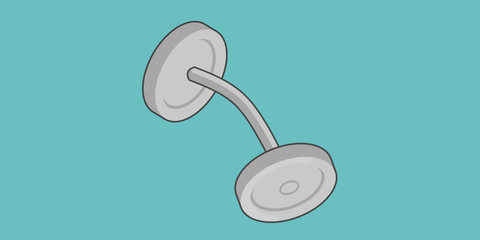
Due to society’s expectations and rigid gender performance standards, erectile dysfunction (ED) can be a daunting prospect for men. You might think the problem is squarely on something intrinsically wrong with your penis — so you might be surprised to learn that your struggles might be due to an underdeveloped set of pelvic floor muscles.
For most men, the pelvic floor muscles aren’t exactly their priority when hitting the gym for a full body workout — but they should be. These muscles are critical for many essential daily functions, both in the bathroom and in the bedroom. Unfortunately, it’s not commonplace for men to seek out help to strengthen their pelvic muscles.
When men hurt themselves playing sports or otherwise, they’re likely not going to be embarrassed to seek out an orthopedist or physical therapist (PT) for help — but when it comes to an injury or problem with their muscles “down there,” man tend to be a little more… private.
Despite common belief and focus on keeping up macho appearances, pelvic floor (PF) dysfunction isn’t just a woman problem. Leakage with squats, pain during or after sex, and bowel or bladder incontinence are all signs of PF muscle dysfunction. Let it be known that penises have muscles, too. And sometimes, like any other muscle in your body, they can be dysfunctional — so you should see a PT about those muscles, too.
Facing Real Problems

ED is a common and growing problem facing thousands of men in the US (pun intended). According to the 2010 US Census Bureau, more than 12 million men between the ages of 40 and 79 experience ED. More recent research suggests that as much as a quarter of men under the age of 40 do, too. Despite its prevalence, most men treat the same way: Using medication. But what if I told you that you could see a physical therapist for your ED to solve the problem naturally? According to research, you can.
Erectile dysfunction is defined as the inability to achieve or maintain an erection. There can be many causes of ED ranging from the emotional and psychological to the physical or neurological. “Pelvic floor physical therapy can address the muscular and nerve function required to achieve and maintain an erection,” pelvic floor specialized Doctor of Physical Therapy Dr. Erin Weber, PT, DPT told MensHealth.com. Specifically, targeted PT can help a man strengthen and engage his ischiocavernosus muscle, which is responsible for building and keeping penile rigidity. That engagement can be honed through exercises like kegels, which have grown more common among women but are woefully underperformed by men.
Just like any other muscle, the pelvic floor muscles can be addressed with rehabilitation. A proper strengthening routine can target weakness — specifically, trigger points can be released where there is increased tension, restoring the correct length-tension relationship and creating more complete and stronger muscle contractions, according to Dr. Weber.
But before you start getting too creative with a DIY strengthening and massage routine, you’ll want a qualified specialist to assess and identify the source of the problem before determining the most appropriate treatment plan.
What Goes Into Treatment

Getty ImagesHero Images
You’d be surprised what PF PT might entail. “Pelvic floor PT is much more than range of motion exercises, soft tissue mobilization and home exercises,” Dr. Francesca Warner, PT, DPT, CSCS, a Doctor of Physical Therapy who specializes in treating male and female pelvic health, told MensHealth.com.
A big focus of her treatments is on patient education and lifestyle adjustments. In particular, Dr. Warner highlighted the importance of breathing and relaxation techniques. “Your diaphragm and your pelvic floor muscles are connected, therefore proper breathing is paramount.”
Additionally, stress can exacerbate pelvic pain. Warner noted that many people hold stress in their pelvis, just like others do in their neck and shoulders. Patient education on avoiding straining when going to the bathroom, not clenching muscles throughout the day, and global relaxation strategies such as meditation and mindfulness can be a large part of her treatments.
So why aren’t more men seeking physical therapy for their ED? According to Dr. Weber, who treats mostly women, men aren’t the only ones lacking knowledge about the muscle group. “Women are just starting to talk (whisper) about their pelvic floors, but only because they go through childbirth.”
Dr. Warner believes the main reason men don’t seek pelvic floor physical therapy is because they don’t know it exists. “While there are a handful of excellent urologists, gastroenterologists, orthopedists and pelvic pain specialists who refer patients to PF physical therapy, unfortunately not all doctors are aware of this specialization (especially when it comes to men),” she said.
Dr. Warner believes part of the issue has to do with common misconceptions. She noted that men are often told ED is related to anxiety. When all the diagnostic testing and urine cultures are negative, they are treated with anti-anxiety medications before their pelvic floor muscles are thoroughly assessed. This can be particularly frustrating for men who begin to think “it’s all in their head,” when there is undoubtedly a muscular component to their pain or discomfort.
Not Just a “Woman Thing”
Not convinced yet? Know this: A pelvic floor exam by a physical therapist may involve both external and internal soft tissue, neurological, strength and range of motion assessments.
By internal, this usually means very gentle assessment of the pelvic floor muscles via the rectum — so yes, you will need to be ready for the rubber gloves to go on. PF PTs know this may be uncharted territory for many men, so you should also know that internal exams usually don’t happen on the initial visit. Such procedures are always discussed prior to the exam and are only performed when a medical history and complete examination indicate that it is appropriate.
“I often hear ‘how come it took seven different doctors to get me here?’ or ‘I wish I had known about this three, five, 15 years ago,’” said Dr. Warner. Above all, she wants men to know that they are not alone and there is help out there. “I am frequently asked ‘Have you ever treated this before?’ My patients seem shocked to hear that, not only are they not my first patient suffering from these symptoms, but they are usually one of three I’ve treated that day.”
Hopefully the stigma of pelvic floor PT being just a “woman thing” will change as men learn more about the prevalence of male pelvic floor dysfunction. Pelvic floor PT can help, so remember: Your struggles might not be in your head.
Source: Read Full Article
